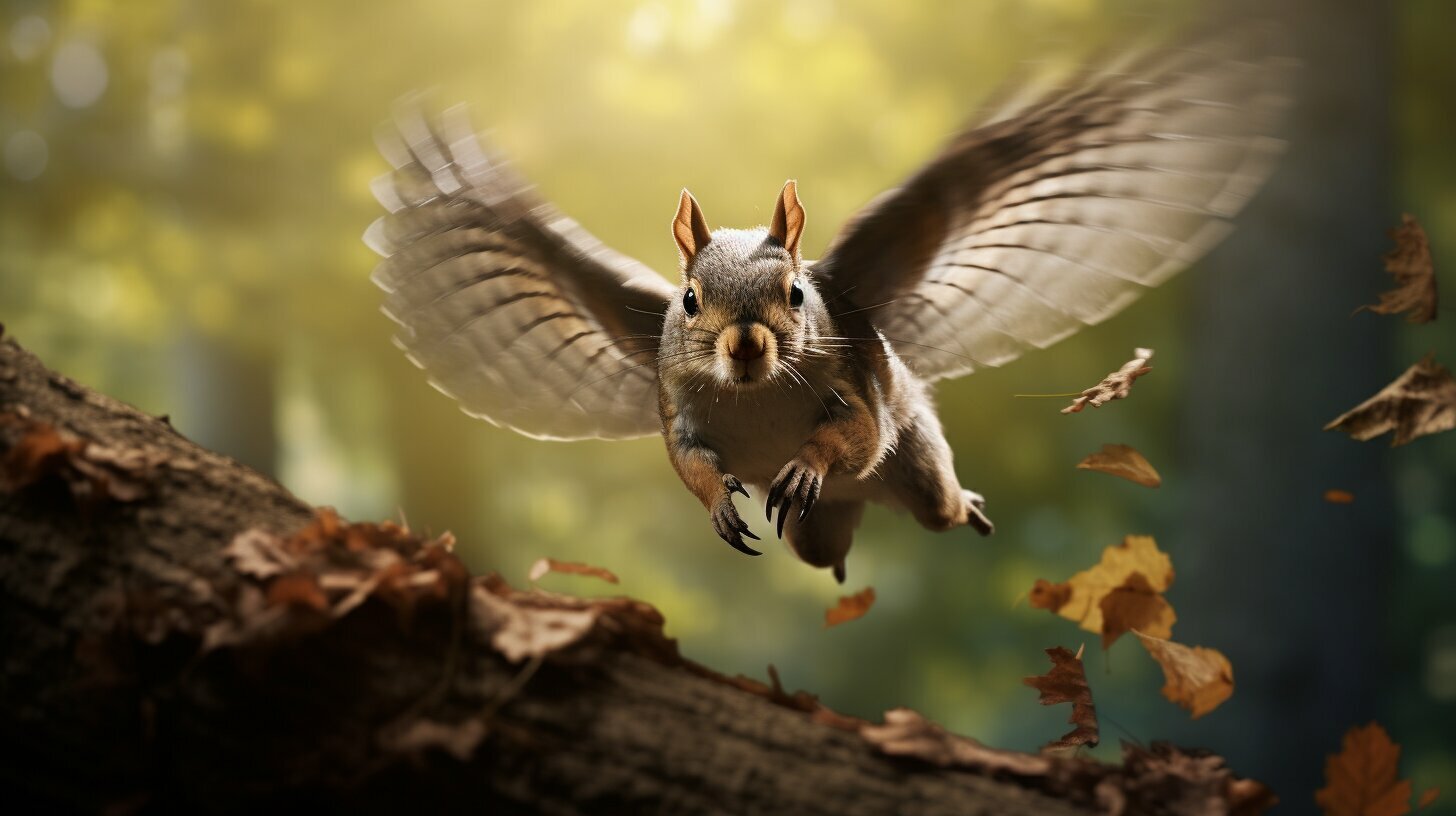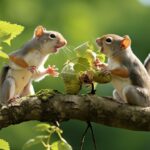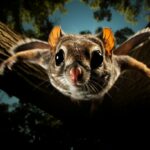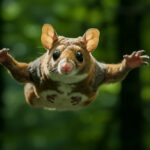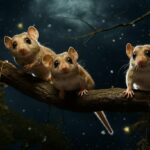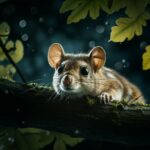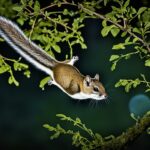Flying squirrels play a crucial ecological role in US forests, contributing to the health and biodiversity of these natural habitats. The northern flying squirrel, in particular, serves as an indicator species, reflecting the overall health of forest ecosystems and environmental changes. These fascinating creatures rely on old-growth forests and are sensitive to disturbance and isolation, making them ideal indicators of landscape connectivity.
The transformation of forests due to human activities, such as deforestation during European settlement, has had a significant impact on the habitat of flying squirrels. In Pennsylvania forests, for example, the decline of northern flying squirrels is being seen, with the southern flying squirrel taking over. This change in squirrel populations could have significant implications for forest ecology.
Their preference for coniferous forests is crucial as they feed primarily on truffle-like fungi. These fungi are important for the health of conifer stands, and the decline of the northern flying squirrel could result in fewer fungi, which would then lead to added stress on trees and impact other species that rely on conifer habitats.
In dry western forests, fuel reduction treatments are used to reduce the risk of high severity wildfires. However, these treatments can also negatively impact the northern flying squirrel, which is associated with late seral forests. The effects of these treatments on squirrel density and distribution vary and are influenced by the landscape context.
Understanding the impact of forest management practices on wildlife requires considering the landscape context. Fuel reduction treatments can lead to a more homogenous and less diverse forest structure, which may have negative consequences for the northern flying squirrel and other species associated with late-seral habitats.
Despite the potential negative impacts of fuel reduction treatments, it is crucial to maintain diverse forest communities. The heterogeneity created by fire disturbances is necessary for the overall health and balance of forest ecosystems.
Key Takeaways:
- Flying squirrels, particularly the northern flying squirrel, contribute to the health and biodiversity of US forests.
- They serve as indicator species, reflecting the overall health of forest ecosystems and environmental changes.
- Transformation of forests due to human activities, such as deforestation, has had a significant impact on flying squirrel habitat.
- The decline of northern flying squirrels can lead to added stress on trees and impact other species that rely on conifer habitats.
- Fuel reduction treatments in dry western forests can negatively impact the northern flying squirrel and other species associated with late-seral habitats.
- Understanding the impact of forest management practices on wildlife requires considering the landscape context.
- The heterogeneity created by fire disturbances is necessary to maintain diverse forest communities.
Indicator Species Reflecting Forest Health
The behavior and habitat preferences of flying squirrels make them excellent indicators of forest health and potential environmental changes. These small creatures rely on specific attributes of old-growth forests, including the presence of large trees, canopy cover, and diverse vegetation. They are sensitive to disturbances such as logging and fragmentation, which can disrupt their habitat and impact their population. Therefore, the presence and abundance of flying squirrels in an area can reflect the overall health and connectivity of the forest ecosystem.
Flying squirrels primarily inhabit mature forests with dense canopy cover, as this provides them with ample protection and access to their preferred food sources. Their presence indicates the existence of a healthy and well-established forest ecosystem. If flying squirrels are absent or their numbers are declining, it can suggest degradation or a disturbance in the area, such as habitat loss or fragmentation.
The impact of flying squirrels goes beyond their role as indicators. Through their foraging activities, flying squirrels play a crucial role in maintaining the balance of forest ecosystems. They are known to disperse seeds from the fruits they consume, aiding in the regeneration and diversity of plant species. In addition, they contribute to the decomposition of organic matter by feeding on fungi and truffle-like species, which in turn helps to enrich the soil and support the growth of other plants.
The Importance of Flying Squirrels in Forest Ecosystems
In summary, flying squirrels serve as indicators of forest health due to their specific habitat requirements and sensitivity to disturbances. Their presence or absence can provide valuable insights into the overall ecological condition of forests. Furthermore, these small creatures contribute to the maintenance of forest diversity and ecosystem functioning through their foraging behaviors. Protecting and conserving their habitats is not only essential for their survival but also vital for the health and sustainability of forest ecosystems as a whole.
| Key Points: | The behavior and habitat preferences of flying squirrels make them excellent indicators of forest health. |
|---|---|
| Flying squirrels rely on old-growth forests and are sensitive to disturbances such as logging and fragmentation. | |
| The presence and abundance of flying squirrels can reflect the overall health and connectivity of forest ecosystems. | |
| Flying squirrels contribute to forest diversity through seed dispersal and the decomposition of organic matter. |
Impacts of Forest Transformation on Flying Squirrel Habitat
European settlement and deforestation have significantly impacted the habitat of flying squirrels, raising concerns about their population and ecological role in US forests. The transformation of forests due to human activities has led to a loss of suitable habitat for these fascinating creatures. Flying squirrels, especially the northern species, rely on old-growth forests with specific attributes that provide them with resources and shelter.
With the decline of old-growth forests, the northern flying squirrel populations are at risk, particularly in Pennsylvania forests where the southern flying squirrel is filling the ecological gap. This change in squirrel populations could have far-reaching implications for forest ecology, as the northern flying squirrel plays a crucial role in maintaining the health and balance of coniferous habitats.
The northern flying squirrel’s preference for coniferous forests is not arbitrary. It relies on a diet of truffle-like fungi, which are critical for the health and vitality of conifers. The decline of the northern squirrel could result in a decrease in fungi availability, leading to added stress on trees and impacting other species that depend on these conifer habitats for their survival.
Furthermore, forest management practices aimed at reducing wildfire risk, such as fuel reduction treatments in dry western forests, can also have unintended consequences for the northern flying squirrel. These treatments often result in a more homogenous forest structure, which could negatively impact the squirrel’s density and distribution, as well as other species associated with late-seral habitats. It is essential to consider the landscape context when implementing such practices to ensure that the ecological role of the northern flying squirrel population is preserved.
| Impacts of Forest Transformation on Flying Squirrel Habitat |
|---|
| European settlement and deforestation have significantly impacted flying squirrel habitat. |
| The northern flying squirrel population decline is being observed in Pennsylvania, with the southern flying squirrel taking over. |
| Decline of the northern squirrel could lead to fewer truffle-like fungi, impacting tree health and other species dependent on conifer habitats. |
| Fuel reduction treatments in dry western forests can negatively affect squirrel density and distribution, emphasizing the importance of considering landscape context in forest management. |
Importance of Northern Flying Squirrels in Coniferous Forests
Northern flying squirrels play a vital role in coniferous forests, contributing to the health and stability of these ecosystems through their food web interactions. These fascinating creatures are an essential link in the complex network of species that rely on conifer habitats for their survival.
The northern flying squirrel’s diet primarily consists of truffle-like fungi found in the forest floor. By feeding on these fungi, they play a crucial role in the dispersal of fungal spores, aiding in the growth and reproduction of these important organisms. Additionally, the squirrel’s foraging activities help maintain the balance of fungi populations, preventing any one species from dominating and potentially causing imbalances in the forest ecosystem.
In return, the presence of northern flying squirrels benefits the trees themselves. As they move through the forest canopy, these agile creatures inadvertently dislodge seeds from cones, contributing to the dispersal and regeneration of coniferous trees. Their presence also helps control populations of insects and other invertebrates that may harm or disrupt forest health.
Table: Species Interactions in Coniferous Forests
| Species | Interactions |
|---|---|
| Northern Flying Squirrels | Feed on truffle-like fungi, aid in dispersal of fungal spores, contribute to tree seed dispersal, control insect populations |
| Coniferous Trees | Provide habitat, food, and shelter for northern flying squirrels, benefit from seed dispersal |
| Fungi | Provide food for northern flying squirrels, aid in decomposition and nutrient cycling |
| Insects and Invertebrates | Controlled by northern flying squirrels, prevent damage to coniferous trees |
The intricate interactions between northern flying squirrels, coniferous trees, fungi, and other species create a delicate balance that promotes the overall health and well-being of the forest ecosystem. It is crucial to recognize and protect the habitat and resources that support these interactions to ensure the continued presence and ecological significance of the northern flying squirrel in coniferous forests.
Impact of Declining Northern Squirrel Populations
The decline of northern flying squirrels in US forests raises concerns about their ecological role and the potential consequences for forest biodiversity. These charismatic creatures play a crucial role in the delicate balance of forest ecosystems, particularly in old-growth forests. As an indicator species, their dwindling numbers reflect not only the health of their own population but also the overall well-being of other species and the environment as a whole.
Historically, the northern flying squirrel has relied on the attributes of old-growth forests, their natural habitat, and is highly sensitive to disturbances and isolation. Therefore, their presence or absence serves as a vital indicator of landscape connectivity. However, the transformation of forests due to human activities, such as deforestation, has significantly impacted the squirrel’s habitat. The consequences of this habitat loss are already being observed, such as the decline of northern flying squirrels in Pennsylvania forests where the southern flying squirrel is replacing them.
The shift in squirrel populations has far-reaching implications for forest ecology. The northern flying squirrel has a strong preference for coniferous forests and plays a critical role in the health of these habitats. They primarily feed on truffle-like fungi, which are essential for the vitality of conifer stands. The decline of the northern squirrel population could result in a reduction of fungi availability, leading to increased stress on trees and potentially impacting other species that depend on these coniferous environments.
Furthermore, forest management practices, particularly fuel reduction treatments in dry western forests, can also negatively affect the northern flying squirrel that is predominantly associated with late seral forests. While these treatments aim to reduce the risk of high severity wildfires, they can inadvertently disrupt the squirrel’s habitat. However, the exact impact on squirrel density and distribution varies and is influenced by the landscape context.
Understanding the broader picture of forest management is crucial for preserving wildlife populations. Fuel reduction treatments can lead to more homogeneous and less diverse forest structures, jeopardizing the habitats of the northern flying squirrel and other species associated with late-seral habitats. It is essential to consider the landscape context when implementing forest management strategies to minimize the potential negative consequences for biodiversity and maintain the delicate balance of forest communities.
| Key Points |
|---|
| The decline of northern flying squirrels in US forests raises concerns for forest biodiversity and their ecological role. |
| They serve as an important indicator species, reflecting the health of other species and the overall environment. |
| The transformation of forests due to human activities has significantly impacted their habitat, with consequences already observed in Pennsylvania forests. |
| The northern flying squirrel is crucial for coniferous forests, feeding on fungi and contributing to the health of these habitats. |
| Forest management practices, particularly fuel reduction treatments, can disrupt the squirrel’s habitat, highlighting the importance of considering landscape context. |
Effects of Forest Management Practices on Flying Squirrel Habitat
Forest management practices, such as fuel reduction treatments, can have varying effects on flying squirrel habitat and population dynamics, highlighting the importance of considering the broader landscape context. The northern flying squirrel, which plays a crucial ecological role in US forests, relies on specific old-forest attributes and is sensitive to disturbance and isolation. Therefore, any alterations to their habitat can have significant consequences for their populations and the overall health of forest ecosystems.
For instance, in dry western forests, fuel reduction treatments are often implemented to reduce the risk of high severity wildfires. While these treatments aim to protect these forests, they can inadvertently impact the northern flying squirrel, which typically occupies late seral forests. The effects of these treatments on squirrel density and distribution, however, are influenced by the landscape context.
It is essential to consider the potential negative impacts of fuel reduction treatments on the northern flying squirrel and other species associated with late-seral habitats. These treatments can result in a more homogenous and less diverse forest structure, which can have negative consequences for wildlife. Maintaining a diverse forest structure is crucial for supporting a wide range of species, including the northern flying squirrel.
| Forest Management Practice | Effect on Flying Squirrel Habitat |
|---|---|
| Fuel Reduction Treatments | Varies depending on landscape context; can result in a more homogenous forest structure, potentially impacting squirrel density and distribution. |
While fuel reduction treatments have their benefits, it’s important to strike a balance between fire management and the conservation of wildlife habitats. Preserving heterogeneous forest structures, created through fire disturbances, is necessary for maintaining the diverse communities of flora and fauna that depend on these forests, including the northern flying squirrel.
Maintaining Forest Diversity for Flying Squirrel Conservation
Maintaining forest diversity is crucial for the conservation of flying squirrels and the overall health and balance of forest ecosystems. The northern flying squirrel plays a significant role in the ecology of US forests, particularly in old-growth forests. It serves as an indicator species, reflecting the health of other species and environmental changes. The squirrel relies on specific attributes of old forests and is sensitive to disturbance and isolation, making it an ideal indicator of landscape connectivity.
The transformation of forests due to European settlement, such as deforestation, has had a significant impact on the squirrel’s habitat. Sadly, there has been a decline in northern flying squirrels within Pennsylvania forests, where the southern flying squirrel is taking over. This change in squirrel populations could have far-reaching implications for forest ecology.
The northern flying squirrel prefers coniferous forests and plays a vital role in the health of these habitats. It feeds primarily on truffle-like fungi, which are essential for the well-being of conifer stands. The decline of the northern squirrel could result in fewer fungi, leading to added stress on trees and impacting other species that rely on coniferous habitats.
Fuel reduction treatments in dry western forests, aimed at reducing the risk of high severity wildfires, can also have negative implications for the northern flying squirrel. Being associated with late seral forests, these treatments can alter squirrel density and distribution. However, the effects of these treatments vary depending on the landscape context. Understanding the impact of forest management practices on wildlife requires considering the broader environmental setting.
While fuel reduction treatments may have potential negative impacts, it is crucial to recognize that the heterogeneity created by fire disturbances is necessary to maintain diverse forest communities. Striking a balance in forest management practices is essential for the preservation of flying squirrel populations and the overall ecological integrity of our forests.
FAQ
Q: What is the ecological role of flying squirrels in US forests?
A: Flying squirrels play a crucial role in the ecology of US forests, particularly in old-growth forests. They serve as indicator species, reflecting the health of other species and environmental changes.
Q: What are the habitat requirements of flying squirrels?
A: Flying squirrels rely on old-forest attributes and are sensitive to disturbance and isolation. They prefer coniferous forests and are associated with late seral forests.
Q: How does forest transformation impact flying squirrel habitat?
A: The transformation of forests due to European settlement, such as deforestation, has had a significant impact on flying squirrel habitat. The decline of the northern flying squirrel is being seen in Pennsylvania forests, where the southern flying squirrel is taking over.
Q: What do flying squirrels eat?
A: Flying squirrels primarily feed on truffle-like fungi, which are important for the health of conifer stands. The decline of the northern squirrel could result in fewer fungi, leading to added stress on trees and impacting other species that rely on conifer habitats.
Q: How do fuel reduction treatments impact flying squirrels?
A: Fuel reduction treatments in dry western forests, aimed at reducing the risk of high severity wildfires, can negatively impact the northern flying squirrel. The effects on squirrel density and distribution vary and are influenced by the landscape context.
Q: Why is maintaining forest diversity important for flying squirrel conservation?
A: Maintaining forest diversity is important for the conservation of flying squirrels and other wildlife. Fuel reduction treatments can lead to a more homogenous and less diverse forest structure, which may have negative consequences for the northern flying squirrel and other species associated with late-seral habitats. The heterogeneity created by fire disturbances is necessary to maintain diverse forest communities.

